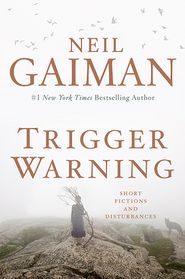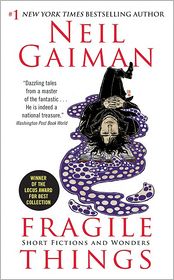Trigger Warning: Bite-Size Disturbances From Neil Gaiman
 To capture the essence of Neil Gaiman, you have first to imagine him seated at a typewriter on a coal-black steam engine bound for nowhere. He glances at his pocket watch and gives Amanda Palmer a knowing look, for he has made a deal with someone—not the devil; nothing is that easy in a Gaiman story—and that someone is coming to collect.
To capture the essence of Neil Gaiman, you have first to imagine him seated at a typewriter on a coal-black steam engine bound for nowhere. He glances at his pocket watch and gives Amanda Palmer a knowing look, for he has made a deal with someone—not the devil; nothing is that easy in a Gaiman story—and that someone is coming to collect.
Gaiman devotees are nodding along, because they know that no one conjures the supernatural, the otherworldly, the gothic, the fantastical, or the bittersweet quite like fiction’s master of the earnest macabre.
Trigger Warning: Short Fictions and Disturbances
Trigger Warning: Short Fictions and Disturbances
By Neil Gaiman
Hardcover $26.99
He’s at it once more with his third collection of short stories, Trigger Warning: Short Fictions and Disturbances. That title, which in internet parlance refers to content that could cause upset or anxiety in readers, tells you much of what you need to know about the stories within.
“There are things in this book, as in life, that might upset you,” Gaiman writes in his introduction. “There is death and pain in here, tears and discomfort, violence of all kinds, cruelty, even abuse. There is kindness, too.”
If ever there were a sentence to sum up this author’s sweet spot, I’d wager that’s it. He is in his comfort zone when he’s making others uncomfortable, and he’s clearly feeling right at home in these 24 stories, including another—and possibly final—check-in on American Gods‘ Shadow.
Gaiman is best-known for his long-form work in comics and novels, but it’s in his short fiction that the full range of his talent is revealed. He not only shows off his, “inexhaustible supply of darkness,” but asserts himself as Friend of the Nerds and Lord of the Fantastic. From a touching tribute to one of science fiction’s greats (“The Man Who Forgot Ray Bradbury”), to fairy tale reimaginings (“Observing the Formalities” and “The Sleeper and the Spindle”), to—praise be, Whovians—a trip in the TARDIS with Matt Smith’s Eleventh Doctor (“Nothing O’Clock”), these stories celebrate and subvert the familiar in unexpected, sometimes troubling, ways.
He’s at it once more with his third collection of short stories, Trigger Warning: Short Fictions and Disturbances. That title, which in internet parlance refers to content that could cause upset or anxiety in readers, tells you much of what you need to know about the stories within.
“There are things in this book, as in life, that might upset you,” Gaiman writes in his introduction. “There is death and pain in here, tears and discomfort, violence of all kinds, cruelty, even abuse. There is kindness, too.”
If ever there were a sentence to sum up this author’s sweet spot, I’d wager that’s it. He is in his comfort zone when he’s making others uncomfortable, and he’s clearly feeling right at home in these 24 stories, including another—and possibly final—check-in on American Gods‘ Shadow.
Gaiman is best-known for his long-form work in comics and novels, but it’s in his short fiction that the full range of his talent is revealed. He not only shows off his, “inexhaustible supply of darkness,” but asserts himself as Friend of the Nerds and Lord of the Fantastic. From a touching tribute to one of science fiction’s greats (“The Man Who Forgot Ray Bradbury”), to fairy tale reimaginings (“Observing the Formalities” and “The Sleeper and the Spindle”), to—praise be, Whovians—a trip in the TARDIS with Matt Smith’s Eleventh Doctor (“Nothing O’Clock”), these stories celebrate and subvert the familiar in unexpected, sometimes troubling, ways.
Fragile Things: Short Fictions and Wonders
Fragile Things: Short Fictions and Wonders
By Neil Gaiman
In Stock Online
Paperback $9.99
With a dizzying array of storytelling devices—“ORANGE” tells the boggling, charming tale of tanning cream gone awry solely through the answers of a teenager’s response to an investigator’s questionnaire—Gaiman manages to find ways to surprise.“The Thing About Cassandra” (a surefire hit for lovers of “The Facts in the Case of the Departure of Miss Finch” from Fragile Things) seems to be a story about two friends remembering long-lost loves, but when one of them seems to recall meeting the girl the other one only made up to impress his friends, we’re left unsure of what’s true and who we can trust.
Some of these works have appeared elsewhere; some have been the product of unusual collaborations (“The Truth Is a Cave in the Black Mountains”). Pulled together, they demonstrate the remarkable breadth of Gaiman’s imagination. It’s gobsmacking that from the same mind that yielded “Feminine Endings,” told from the gleefully disturbing point of view of a human statue, can also spring a delightful, yet prescient Sherlock Holmes yarn like “The Case of Death and Honey.”
Truth be told, packaged together, these stories say as much about us as they do about their author.
“What we learn about ourselves in those moments, where the trigger has been squeezed is this: the past is not dead,” Gaiman explains of his fascination with trigger warnings. “There are things that wait for us, patiently, in the dark corridors of our lives … They have been waiting there in the darkness, working out, practicing their most vicious blows.”
His supply of darkness? It’s something not to fear, but to treasure.
With a dizzying array of storytelling devices—“ORANGE” tells the boggling, charming tale of tanning cream gone awry solely through the answers of a teenager’s response to an investigator’s questionnaire—Gaiman manages to find ways to surprise.“The Thing About Cassandra” (a surefire hit for lovers of “The Facts in the Case of the Departure of Miss Finch” from Fragile Things) seems to be a story about two friends remembering long-lost loves, but when one of them seems to recall meeting the girl the other one only made up to impress his friends, we’re left unsure of what’s true and who we can trust.
Some of these works have appeared elsewhere; some have been the product of unusual collaborations (“The Truth Is a Cave in the Black Mountains”). Pulled together, they demonstrate the remarkable breadth of Gaiman’s imagination. It’s gobsmacking that from the same mind that yielded “Feminine Endings,” told from the gleefully disturbing point of view of a human statue, can also spring a delightful, yet prescient Sherlock Holmes yarn like “The Case of Death and Honey.”
Truth be told, packaged together, these stories say as much about us as they do about their author.
“What we learn about ourselves in those moments, where the trigger has been squeezed is this: the past is not dead,” Gaiman explains of his fascination with trigger warnings. “There are things that wait for us, patiently, in the dark corridors of our lives … They have been waiting there in the darkness, working out, practicing their most vicious blows.”
His supply of darkness? It’s something not to fear, but to treasure.

